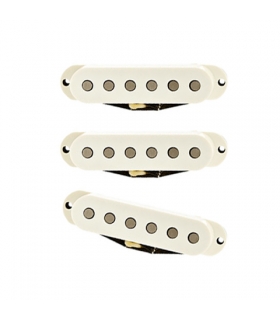




Vintage Blackface con Flat Pole
Set di 3 pickup singlecoil per Stratocaster, cover color Parchment
Product Details
Featuring a pre-CBS 1960s Strat®-style wind, our Strat Blackface Pickups give you a classic Strat tone with full body and punch. The overall tone has a prominent midrange, clear treble, and full bass with a well-defined, piano-like attack. We use scatter wound wax potted coils with Alnico 5 magnets degaussed to vintage 60s Strat pickup specs and flat-poles for added presence. Includes medium output with vintage style cloth covered lead wire. Middle is RWRP for humbucking operation in positions 2 and 4.
DC: Neck 6.4K, middle 6.5K, and bridge 6.8K.
FLAT POLE VS. STAGGERED POLE PICKUPS
Read about the differences between Flat Pole and Staggered Pole Pickups.
If you compared a flat-pole pickup to a staggered-pole pickup wound the same way, you would get a little more presence (like a Fender Amp presence knob), a little more bass and a little more overall output from the flat-pole pickup. Another way to think about it is that a flat-pole pickup will generate a little more output without putting more wire on the pickup coil. Adding more wire changes the frequency response, usually by losing some treble and gaining some bass. If you are already used to using staggered-pole pickups, you may find that you will need to turn the bass down slightly on the amplifier because with a flat-pole pickup you will no longer have to make up for weak low strings.
In most cases the flat-pole pickup will give you a better string balance. The high E won't get buried in the mix like a staggered-pole pickup can. You will also notice that the two low strings are louder than a staggered-pole set, and the G string does not overpower the others.
On a staggered-pole pickup the low strings rarely overpower any amp, but they can also sound somewhat subdued or weak. The volume on the G string tends to dominate all others. If you have previously played using only staggered-poles and you don't notice any discrepancies with string-to-string volume balance, you have learned to compensate for them. If you decide to try a flat-pole set, it may take some time to adapt but once you get familiar with the sound, you'll find they work better in most cases than a staggered-pole design. For example, all Teles up until around 1956 had flat-poles — and no one ever comments that their 1952 Telecaster has bad string balance. Also, most Telecasters, Jazzmaster, Mustangs and Fender bass guitars have historically had flat-pole pickups. On Gibson guitars no one ever staggers the adjustable poles as much as Strat pickups.
